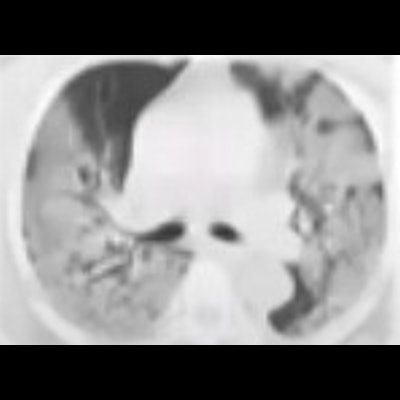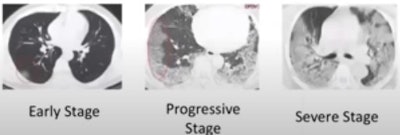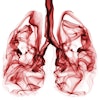
A project called the Medical Imaging and Data Resource Center (MIDRC) is offering key support for the development of artificial intelligence (AI) for the diagnosis and treatment of COVID-19, according to a presentation delivered May 5 at the AuntMinnie.com Spring 2021 Virtual Conference.
Presenter Maryellen Giger, PhD, of the University of Chicago, described AI's important role in the management of COVID-19 patients, and how MIDRC can help.
"We know COVID-19 impacts the lungs, the heart, the vessels, and the brain," she said. "What we want to do is collect medical images and develop AI methods to aid in the analysis and interpretation of those images."
Public health crisis
The COVID-19 pandemic is an urgent and critical public health crisis, and biomedical research and development is needed to address surveillance of the disease and early detection, diagnosis of the condition and predicting its severity, predicting and assessing treatment response, and monitoring post-COVID-19 patients, Giger said. AI and imaging are crucial to these tasks.
"We want to ask questions about the relationships between the features seen in medical images and the biology of disease so that eventually we can detect and diagnose disease early and give the right treatment to the right patient at the right time," she said. "AI also improves the efficacy and workflow of medical imaging interpretation."
Giger noted that many AI algorithms are being developed to address COVID-19, with some using human-engineered radiomic features, some using deep learning (including transfer learning techniques), and some combining algorithms. All this is in service of tailoring treatment and optimizing the use of medical resources, she said.
 Various stages of COVID-19 shown on chest CTs from three different patients. Images courtesy of Maryellen Giger, PhD.
Various stages of COVID-19 shown on chest CTs from three different patients. Images courtesy of Maryellen Giger, PhD."[AI and imaging help clinicians] decide on appropriate treatment, monitor that treatment, and predict response to it," she said.
A key obstacle to "successful and meaningful machine learning algorithms is a lack of diverse data," Giger noted. That's where MIDRC comes in.
"MIDRC's aim is to expedite the development of AI for the clinical management of COVID-19," she said.
Making the most of MIDRC
MIDRC was established in August of last year and is funded by the U.S. National Institute of Biomedical Imaging and Bioengineering (NIBIB). It is led by the American Association of Physicists in Medicine (AAPM), the American College of Radiology (ACR), and the Radiological Society of North America (RSNA), and it is also supported by the University of Chicago's Gen3 Data Commons. Its goal is to "establish a high-quality and diverse data commons ... that enables researchers to address topics no single archive could yield independently," Giger said.
The organization is working on a variety of technology projects, including the following:
- Creating an open discovery platform for COVID 19 and associated data (led by the RSNA)
- Creating a real-world testing and implementation platform with direct real-time connections to healthcare delivery orgs (led by the ACR)
- Developing and implementing quality assurance and evaluation procedures for usage across MIDRC (led by the AAPM)
- Enabling data intake, access, and distribution via a data commons portal (led by all of the above plus Gen3)
- Linking MIDRC to other clinical and research data registries (led by all of the above plus Gen3)
MIDRC has two data intake portals: the RSNA's International COVID-19 Open Radiology Database (RICORD) and the ACR's COVID-19 Imaging Research Registry (CIRR). Its output portal is run by Gen3 Data Commons.
"The goal is to have [MIDRC] accessed by hundreds of AI researchers and developers for training and testing, to reduce bias and enhance diversity, and to expedite the translation of AI to clinical care," Giger said.
Currently, MIDRC has 14 institutions working to donate data through the RSNA; 40,000 images are being processed and 10,000 considered for donation to the database, according to Giger. The hope is to release 60,000 curated COVID-19 imaging studies by this September. The group is also establishing relationships with leaders of other COVID-19 data repositories, such as the following:
- The National COVID Cohort Collaborative from NIH's National Center for Advancing Translational Sciences (NCATS)
- The Society of Critical Care Medicine's Viral Infection and Respiratory Illness Universal Study (VIRUS) and Prevention and Early Treatment of Acute Lung Injury (PETAL) COVID-19 Observational Study (CORAL) project
- The American Society of Neuroradiology
- The American Institute of Ultrasound in Medicine
- The National Heart, Lung, and Blood Institute's (NHLBI) BioData Catalyst cloud-based platform
What's next for MIDRC? Adding cardiovascular and neurological images to the pool of chest x-ray and CT exams; including images that can be used for treatment monitoring; and working with other COVID-19 data commons groups to incorporate clinical data, imaging exams, histology, and genomics, according to Giger.
The hope is that MIDRC will serve as a national resource, she said.
"For a given medical image, a patient has already benefited through medical care, and a hospital or medical center has already benefitted through reimbursement," she said. "Now the public can benefit with the MIDRC secondary use of the images. We can all help change the future of medical imaging and increase its impact on public health."




















